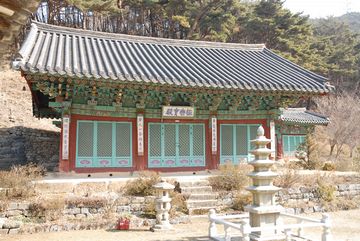"서산 문수사 극락보전"의 두 판 사이의 차이
Mkichukova (토론 | 기여) (→영문) |
|||
| 35번째 줄: | 35번째 줄: | ||
Geungnakbojeon is a Buddhist worship hall for the veneration of Amitabha Buddha, who is believed to guide the dead to be reborn in the Buddhist paradise of the West. | Geungnakbojeon is a Buddhist worship hall for the veneration of Amitabha Buddha, who is believed to guide the dead to be reborn in the Buddhist paradise of the West. | ||
| + | |||
| + | It is unknown when Geungnakbojeon Hall of Munsusa Temple was first built, but the current building is presumed to have undergone reconstructions in 1630. It measures three intervals in width and three intervals in depth, with its roof being a gable roof. The intricate support brackets, which help distribute the roof’s weight, are positioned atop each lintel as well as between the pillar-top brackets(?). This building has high architectural value since it embodies various architectural styles of the Joseon period (1392-1910) as the style of the time of its reconstruction in the 17th century as well as the reconstructions and repair work after this. In addition, the multicolored patterns inside the building have artistic and academic value as they verify the change in designs and colors over time after the 17th century. | ||
| + | |||
| + | Munsusa Temple in Seosan is presumed to be a temple built before the late period of the Goryeo dynasty (918-1392). Because in 1973, in the process of excavating excavated relics of the gilt-bronze seated Buddha enshrined in Geungnakbojeon Hall, a record about the creation of the statue written in 1346 was found. In the town chronicles of Seosan compiled in 1619, it is said that Munsusa Temple had burned down and only one building remained, but historical records recorded about Munsusa Temple after the 18th century, records about the creation of Buddhist statues and Buddhist paintings, and historical records(?) that have been passed down suggest that the temple was managed intermittently. | ||
===영문 해설 내용=== | ===영문 해설 내용=== | ||
2024년 6월 9일 (일) 22:04 판
| 문수사 극락보전 |
|
 문수사 극락보전, 국가유산포털, 국가유산청. |
|
| 대표명칭 | 문수사 극락보전 |
|---|---|
| 한자 | 文殊寺 極樂寶殿 |
| 주소 | 충청남도 서산시 문수골길 201 |
| 지정번호 | 충청남도 유형문화유산 |
| 지정일 | 1973년 12월 26일 |
| 분류 | 유적건조물/종교신앙/불교/불전 |
| 수량/면적 | 1동 |
| 웹사이트 | 문수사 극락보전, 국가유산포털, 국가유산청. |
해설문
국문
서산 문수사는 고려말 이전에 건립된 사찰로 추정된다. 1973년 극락보전에 안치된 금동여래좌상의 복장유물* 조사에서 1346년(충목왕 2)에 쓴 불상 조성기가 발견되었기 때문이다. 조선시대에도 『신증동국여지승람』(1530년)에서 문수사가 확인되며, 『호산록』(1619년)에서는 불타버리고 2칸짜리 전각만이 남아 있다고 했지만 18세기 이후로도 문헌자료와 불상 및 불화 조성기, 중수기가 전해져 사찰이 지속적으로 운영된 것을 알 수 있다.
극락보전은 서방 극락정토(極樂淨土)의 주재자인 아미타불을 본존불로 모신 법당이다. 문수사의 극락보전은 건립연대를 알 수 있는 자료는 없지만, 현재 건물은 주요 구조부에 대한 과학적 분석 등을 통해 1630년대 중건된 것으로 본다.
이 건물은 정면 3칸, 옆면 3칸이며, 지붕은 옆면에서 볼 때 사람 인(人)자 모양을 한 맞배지붕이다. 지붕 처마를 받치기 위해 장식하여 만든 공포는 기둥 위뿐만 아니라 기둥과 기둥 사이에도 조성된 다포 양식이다. 이 건물은 17세기 중건 당시의 형식과 이후 중수 및 보수를 거치면서 다양한 조선시대 건축 양식을 지니고 있어 건축학적 가치가 높고, 건물 내부의 단청에서는 17세기 이후 문양과 채색의 시기별 변화가 확인되어 예술적·학술적 가치가 있다.
- 복장유물(腹藏遺物): 불상을 만들 때, 가슴 안쪽에 넣는 유물
영문
Geungnakbojeon is a Buddhist worship hall for the veneration of Amitabha Buddha, who is believed to guide the dead to be reborn in the Buddhist paradise of the West.
It is unknown when Geungnakbojeon Hall of Munsusa Temple was first built, but the current building is presumed to have undergone reconstructions in 1630. It measures three intervals in width and three intervals in depth, with its roof being a gable roof. The intricate support brackets, which help distribute the roof’s weight, are positioned atop each lintel as well as between the pillar-top brackets(?). This building has high architectural value since it embodies various architectural styles of the Joseon period (1392-1910) as the style of the time of its reconstruction in the 17th century as well as the reconstructions and repair work after this. In addition, the multicolored patterns inside the building have artistic and academic value as they verify the change in designs and colors over time after the 17th century.
Munsusa Temple in Seosan is presumed to be a temple built before the late period of the Goryeo dynasty (918-1392). Because in 1973, in the process of excavating excavated relics of the gilt-bronze seated Buddha enshrined in Geungnakbojeon Hall, a record about the creation of the statue written in 1346 was found. In the town chronicles of Seosan compiled in 1619, it is said that Munsusa Temple had burned down and only one building remained, but historical records recorded about Munsusa Temple after the 18th century, records about the creation of Buddhist statues and Buddhist paintings, and historical records(?) that have been passed down suggest that the temple was managed intermittently.
영문 해설 내용
극락보전은 죽은 이를 서방 극락세계로 인도하여 그의 영혼을 구제하는 아미타불을 모신 법당이다.
문수사의 극락보전은 언제 처음 지어졌는지는 알 수 없고, 현재 건물은 1630년대에 중건된 것으로 추정된다. 정면 3칸, 옆면 3칸이며, 지붕은 맞배지붕이다. 지붕의 무게를 받치는 공포는 각 기둥의 위와 기둥과 기둥 사이에도 설치되었다. 이 건물은 17세기 중건 당시의 형식과 이후 중수 및 보수를 거치면서 다양한 조선시대 건축 양식을 지니고 있어 건축학적 가치가 높다. 또한 건물 내부의 단청에서는 17세기 이후 문양과 채색의 시기별 변화가 확인되어 예술적·학술적 가치가 있다.
서산 문수사는 고려말 이전에 건립된 사찰로 추정된다. 1973년 극락보전에 안치된 금동여래좌상의 복장유물을 조사하는 과정에서 1346년에 쓴 불상 조성기가 발견되었기 때문이다. 1619년에 편찬된 서산 읍지에서는 문수사가 불타버리고 전각 하나만이 남아 있다고 했지만, 18세기 이후의 문수사에 대해 기록한 문헌자료와 불상 및 불화 조성기, 중수기가 전해져 사찰이 지속적으로 운영된 것을 알 수 있다.